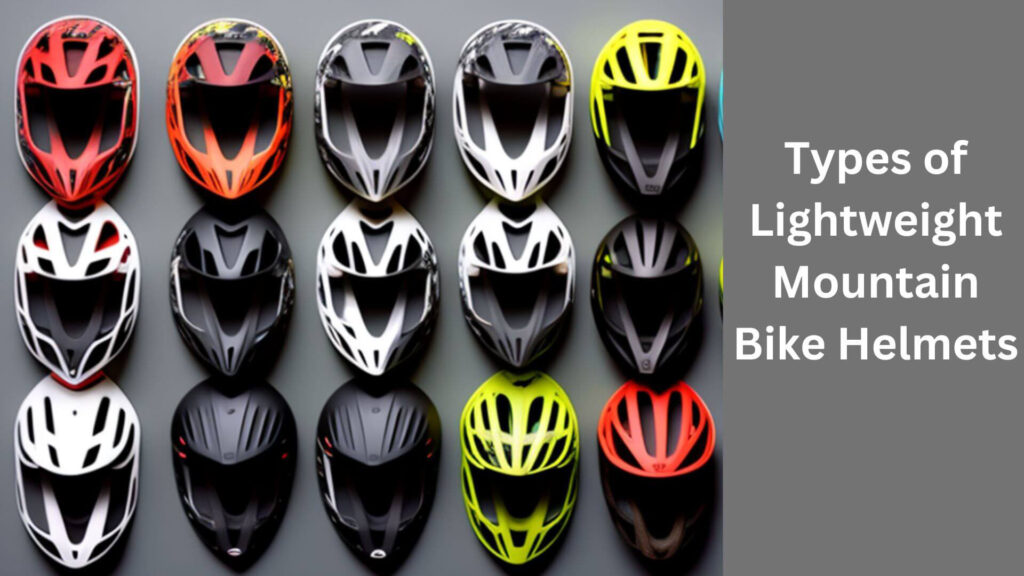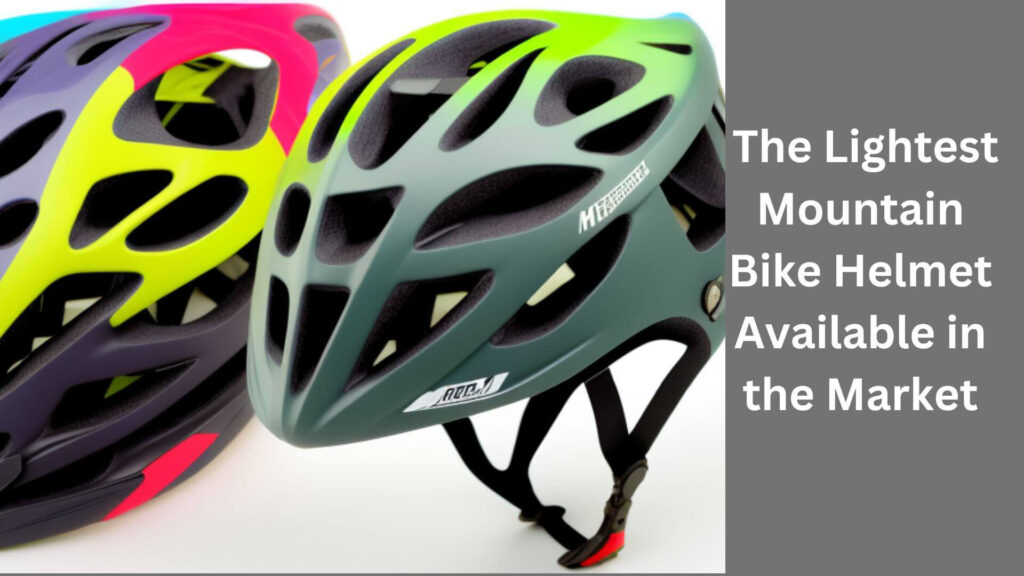What is the Lightest Mountain Bike Helmet?

Regarding mountain biking, safety should always be the top priority. And a good quality helmet is one of the most critical essential gears every rider should invest in.
Yet, with so many possibilities available in the market, it can take time to find the ideal one.
If you’re looking for a lightweight option, you might wonder, “What is the lightest mountain bike helmet?
This article will discuss some of the lightest available mountain bike helmets, their features, and why you should consider purchasing one.
What are the Factors to consider when choosing a mountain Bike Helmet?
When choosing a mountain bike helmet, there are several factors that you should consider to ensure that you get the best one for your needs.
1. Safety standards: Always choose a helmet that meets the safety standards set by organizations such as CPSC, ASTM, or EN.
2. Fit and comfort: The helmet should fit snugly and comfortably on your head, with no pressure points or gaps.
3. Ventilation: The helmet should have adequate ventilation to keep you cool during hot rides.
4. Weight: The helmet’s weight is essential, especially if you want a lightweight option.
5. Style: Choose a style that suits your preferences and needs, whether a full-face or half-shell helmet.
6. Price: Helmets can range from budget-friendly to high-end options, so consider your budget when purchasing.
7. Brand reputation: Look for a reputable brand with a good track record in producing high-quality, safe helmets.
Check Also: Safety Meets Savings: Unveiling the Best Mountain Bike Helmet under $100!
What is the Importance of Wearing a Lightweight Mountain Bike Helmet?
Wearing a lightweight mountain bike helmet is essential for several reasons.
- Firstly, a lighter helmet reduces the strain on your neck and head, allowing you to ride for longer without feeling fatigued.
- Secondly, a lightweight helmet can improve your overall riding experience, as it can feel more comfortable and less cumbersome than a heavier helmet.
- Thirdly, a lighter helmet can also improve your performance, as it can reduce wind resistance and improve your aerodynamics, helping you to ride faster and more efficiently.
Additionally, a lightweight helmet can be essential for competitive riders who must shave off every ounce of weight to gain a competitive edge.
However, it’s important to note that no matter how lightweight a helmet is, it should always meet the appropriate safety standards to ensure maximum protection during a crash.
Read More: Brighten Your Ride: The Top-Rated Mountain Bike Helmet Lights
Types of Lightweight Mountain Bike Helmets

Three lightweight mountain bike helmets are in-mold, hardshell, and hybrid.
● In-Mold Helmets
In-mold helmets have a polycarbonate outer shell and an inner shell of expanded polystyrene foam.
The two shells are fused using heat, making the helmet lightweight and durable. In-mold helmets offer excellent ventilation and are suitable for road and mountain biking.
● Hardshell Helmets
Hardshell helmets have a thick plastic outer shell and an inner foam liner. The two layers are glued together, making the helmet durable but heavier than in-mold helmets. Hardshell helmets are suitable for downhill mountain biking and offer better protection against impacts.
● Hybrid Helmets
Hybrid helmets combine the features of in-mold and hardshell helmets, making them lightweight and durable.
They have a polycarbonate outer shell and an inner foam liner with complex plastic reinforcement in high-impact areas.
Hybrid helmets offer excellent ventilation and are suitable for trail and cross-country mountain biking.
Read More: Replacing My Mountain Bike Helmet After a Crash: Should I?
What is the Lightest Mountain Bike Helmet Available in the Market?

As of March 2023, several lightweight mountain bike helmets are available. However, the exact lightest mountain bike helmet can vary depending on the specific model and size. Currently, one of the most lightweight mountain bike helmets available on the market is:
- The Giro Aether MIPS helmet weighs around 250 grams (size medium).
- Other lightweight options include the Kask Valegro helmet, which weighs around 180 grams (size medium)
- And the Specialized S-Works Prevail II helmet weighs around 215 grams (size medium).
However, it’s important to note that the weight of a helmet should not be the only consideration when choosing one, as other factors such as safety standards, fit, and ventilation are also important.
What are the Features of a Lightweight Mountain Bike Helmet?
A lightweight mountain bike helmet can have several features that make it comfortable and suitable for mountain bike riding.
Here are some of the features you can expect to find in a lightweight mountain bike helmet:
1. In-mold construction: A lightweight helmet often has an in-mold construction, fusing the outer shell with the foam liner, making it lighter and more durable.
2. Ventilation: Lightweight helmets usually have well-designed ventilation systems that allow for better airflow, keeping your head cool and comfortable.
3. Adjustable fit: Many lightweight helmets have adjustable fit systems that allow you to adjust the fit to your head size and shape, ensuring a snug and comfortable fit.
4. Removable padding: Removable padding is a common feature in most lightweight helmets, allowing easy cleaning and maintenance.
5. Visor: A visor is a common feature in many lightweight helmets, which helps to shield your eyes from the sun and debris.
6. MIPS technology: Some lightweight helmets also come with MIPS (Multi-directional Impact Protection System) technology, which can help reduce rotational forces in the event of an impact, improving safety.
7. Lightweight straps: Lightweight helmets often have thin, lightweight straps that are comfortable and don’t add unnecessary weight.
These features work together to create a lightweight, comfortable, and safe helmet, making it an excellent choice for mountain biking.
How Does the Weight of a Mountain Bike Helmet Affect its Safety and Comfort?
A mountain bike helmet’s weight can affect its safety and comfort. Here’s how:
1. Safety: A lighter helmet doesn’t necessarily mean it’s less safe. Many lightweight helmets still meet the same safety standards as heavier helmets.
However, a heavier helmet may provide better protection against specific impacts because it has more foam inside.
A well-designed lightweight helmet with proper construction and impact-absorbing materials can still provide excellent protection.
2. Comfort: A heavier helmet can strain your neck and shoulders, causing discomfort and fatigue, especially during long rides.
A lighter helmet, on the other hand, can reduce this strain, allowing you to ride for more extended periods without discomfort.
Additionally, a lighter helmet can be more comfortable to wear in hot weather, as it can provide better airflow and ventilation.
It’s important to note that the weight of a helmet should not be the sole factor when choosing one. Safety standards, fit, ventilation, and other features are equally important.
Ultimately, the best helmet for you fits well is comfortable to wear, and meets the appropriate safety standards for your riding needs.
What are the Benefits of Investing in a Lightweight Mountain Bike Helmet?
Investing in a lightweight mountain bike helmet can provide several benefits, including:
- Improved comfort: A lightweight helmet can reduce the strain on your neck and head, making it more comfortable to wear during long rides.
- Better ventilation: Many lightweight helmets have well-designed ventilation systems that allow for better airflow, keeping your head cool and comfortable.
- Enhanced performance: A lighter helmet can improve your performance by reducing wind resistance and aerodynamics, helping you ride faster and more efficiently.
- Increased safety: While a lighter helmet doesn’t necessarily mean it’s less safe, a well-designed lightweight helmet can still provide excellent protection during a crash.
- Reduced fatigue: A lighter helmet can reduce fatigue during long rides, allowing you to ride longer without feeling weighed down.
- Better fit: Lightweight helmets often have adjustable fit systems that allow you to adjust the fit to your head size and shape, ensuring a snug and comfortable fit.
- Stylish design: Many lightweight helmets come in various colors and designs, allowing you to choose one that matches your style and preferences.
Overall, investing in a lightweight mountain bike helmet can provide several benefits that can enhance your riding experience and safety.
However, choosing a helmet that meets the appropriate safety standards and fits well, no matter how lightweight, is essential.
What are the Maintenance Tips for a Lightweight Mountain Bike Helmet?
Maintaining your lightweight mountain bike helmet is essential to remain safe and comfortable.
1. Clean the helmet regularly: Use mild soap and warm water to clean the helmet, and avoid using harsh chemicals or solvents that can damage the helmet’s construction.
2. Dry the helmet thoroughly: After cleaning, let the helmet air dry completely, and avoid exposing it to direct sunlight or heat, which can damage the helmet’s materials.
3. Replace the helmet if it’s damaged: If it has been involved in an impact, it’s crucial to replace it, even if there are no visible signs of damage.
4. Store the helmet properly: Store the helmet in a cool, dry place, away from direct sunlight and heat, and avoid stacking heavy objects on top of it, which can damage the helmet’s foam.
5. Replace the helmet pads: Over time, the helmet pads can become worn or dirty and should be replaced to ensure a snug and comfortable fit.
6. Check the helmet’s fit regularly: Make sure the helmet fits snugly and comfortably on your head, and adjust the fit system as needed.
7. Check for cracks or damage: Regularly inspect the helmet for cracks or other signs of wear that could compromise its safety.
Following these maintenance tips ensures that your lightweight mountain bike helmet remains in good condition and provides maximum protection during your rides.
What are the Safety Standards that a Lightweight Mountain Bike Helmet Should Meet?
A lightweight mountain bike helmet should meet the same safety standards as any other mountain bike helmet, regardless of weight.
Here are some of the safety standards that a lightweight mountain bike helmet should meet:
- CPSC (Consumer Product Safety Commission): CPSC is a U.S. safety standard that sets minimum safety requirements for bike helmets sold in the U.S.
- ASTM F1952: ASTM is an international safety standard that sets safety requirements for downhill mountain bike helmets.
- EN-1078: EN-1078 is a European safety standard that sets safety requirements for bike helmets sold in Europe.
- AS/NZS 2063:2008: AS/NZS is an Australian and New Zealand safety standard that sets safety requirements for bike helmets sold in these countries.
Helmets that meet these safety standards have been tested and certified to provide minimum protection during a crash.
When choosing a lightweight mountain bike helmet, looking for one that meets these safety standards to ensure maximum protection during your rides is essential.
What are the Reviews and Recommendations For the Lightest Mountain Bike Helmets on the Market?
There are several lightweight mountain bike helmets available in the market, and here are some reviews and recommendations for them:
- Giro Syntax MIPS: This helmet weighs just 270 grams and comes with a MIPS liner for added protection. It has 25 vents for excellent ventilation and a Roc Loc 5 fit system for a comfortable, secure fit.
- Kask Valegro: Weighing in at just 180 grams, the Kask Valegro is one of the lightest helmets on the market. It has a sleek design and 37 vents for maximum airflow. The Octo Fit system allows for easy adjustment and a secure fit.
- Specialized S-Works Prevail II: This helmet weighs 215 grams and features a MIPS SL liner for enhanced protection. It has a Tri-Fix web splitter for easy strap management and a Mindset HairPort II micro-dial fit system for a comfortable fit.
- POC Octal X SPIN: The POC Octal X SPIN weighs just 215 grams and features POC’s SPIN technology for rotational impact protection. It has 20 vents and an easy-to-use dial adjustment system.
- Bontrager Velocis MIPS: This helmet weighs 252 grams and comes with a MIPS liner for added protection. It has 22 vents and a Boa dial fit system for easy adjustment.
Overall, the lightest mountain bike helmets offer excellent ventilation and comfort while providing crucial protection.
When choosing a helmet, consider fit, ventilation, and safety features to find the best one.
Frequently Asked Questions (FAQs) About What is the Lightest Mountain Bike Helmet?
What is the lightest mountain bike helmet on the market?
The Kask Protone is currently the lightest mountain bike helmet, weighing only 215 grams.
How much should a lightweight mountain bike helmet weigh?
A lightweight mountain bike helmet should weigh between 150 and 250 grams.
Are lightweight helmets less safe than heavier helmets?
No, lightweight helmets can meet the same safety standards as heavier helmets. Choosing a helmet that meets the safety standards set by the relevant authorities is essential.
What is the difference between in-mold and hardshell helmets?
In-mold helmets have a polycarbonate outer shell and an inner shell of expanded polystyrene foam. In contrast, hardshell helmets have a thick plastic outer surface and an inner foam liner.
What should I consider when choosing a lightweight mountain bike helmet?
You should consider safety standards, helmet material, ventilation, comfort and fit, and price when choosing a lightweight mountain bike helmet.
Final verdict
In conclusion, finding the lightest mountain bike helmet is crucial for comfort and safety.
With so many options on the market, it’s essential to consider factors such as weight, ventilation, and impact protection when selecting a helmet.
While there are various contenders for the title of the lightest mountain bike helmet, ultimately, the best option will depend on individual preferences and needs.
By doing a thorough research and prioritizing safety, riders can find a helmet that provides protection and a comfortable, lightweight fit.

Hey, I’m Hrithik Hossain. I am the head of helmethacks.com, which specializes in safety helmets. I am looking to connect with anyone interested in purchasing a helmet or who has any questions about different types of helmets. I have over 8 years of experience as a helmet expert, and I can’t wait to help you find the perfect helmet for you. I can help you with any questions regarding helmets, from the best brands to fitting, style, and more! I really enjoy keeping people safe by ensuring they have the best protection possible.







